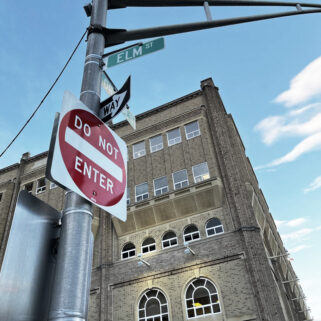Marco Antonio Reyes Alvarez’s bags were almost packed. He had his ticket for a flight the next morning, August 8, to Ecuador, the country he left twenty years ago for the United States. At his home in Meriden—a small city midway between Hartford and New Haven—Fanny Torres Reyes, his wife of twenty-four years, their three children, and thirty relatives had gathered for his final hours in the country. His deportation loomed on the other side of the night.
“We were saying goodbye, crying, making his suitcases,” Torres Reyes remembered. She is forty years old, slight, with expressive eyes and dark brown hair that falls just below her shoulders. “He was even [packing] some tools to bring over there so he would be able to work.”
It would be a two-hour drive to the airport in New York City, a six-and-a-half-hour flight to Ecuador, and a decade before he could begin to petition the United States government for re-entry. That process alone could take up to five years. By then, his twelve-year-old daughter, Adriana, an American citizen, could sponsor her father’s request for readmission. Or maybe one of their other children—twenty-three-year old Evelyn and twenty-one-year-old Anthony, both DACA recipients—would have gained legal status through marriage and could vouch for him. But he would still need to apply for a waiver of his removal order. It could be well over a decade before Reyes Alvarez saw his family again, or perhaps he would never be able to return.
“Muy, muy, muy, muy duro,” Reyes Alvarez said with a heavy sigh, remembering that night. “You had to say good- bye to your son, your wife…”
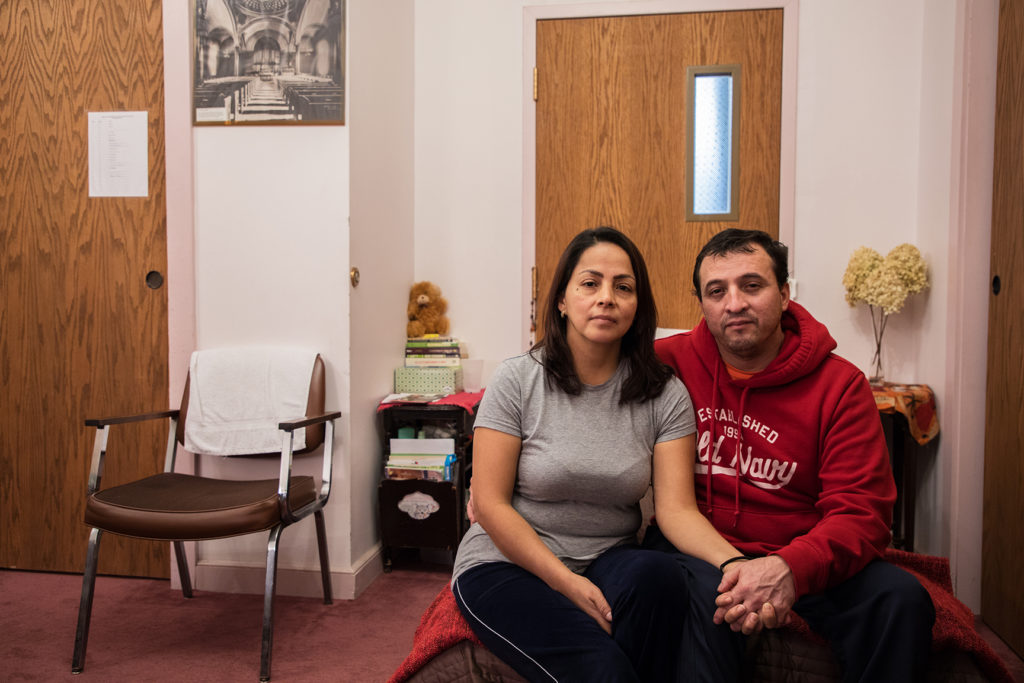
Forty-five years old, Reyes Alvarez has a compact build, a soft, square face, and dark hair trimmed close to his head. He has a quiet gentleness that belies his steadfast resolve. In 1997, he made the two-week trek from Ecuador to Texas, sometimes walking for days on end, in search of better prospects for his family. He settled in Connecticut and established himself as a construction worker skilled in everything from sheetrock and drywall to carpentry and framing. His young family soon joined him. For the next twenty years, he was their sole provider.
Now, years of fighting a deportation order dating back to 2009 would end at dawn. The week before his deportation date, Erin O’Neil-Baker, his Hartford-based attorney, had filed a motion to reopen his case with the Board of Immigration Appeals on the grounds of asylum. If Reyes Alvarez returned to Ecuador, O’Neil-Baker said, he would be in certain danger. His brother-in-law had recently been murdered there by a suspect who, after a brief prison sentence, was now free and threatening other members of the Reyes family.
For the past two years, Reyes Alvarez’s requests for stays of removal had been granted, extending his legal ability to remain in the country. Each request involved demonstrating that he had no criminal record, was employed, and paid taxes. But on June 27, 2017, for the first time, his request was denied. His situation is characteristic of a new trend in immigration court proceedings that began soon after the inauguration of President Donald Trump.
U.S. Immigration and Customs Enforcement (ICE) is “now targeting people with old removal orders, not people with criminal records,” O’Neil-Baker said. “They’re seen as low-hanging fruit.”
In Meriden, Reyes Alvarez’s family cried and prayed as they packed his bags. Late in the evening, friends and members of Unidad Latina en Acción (ULA), a New Haven-based immigrants’ rights group, arrived and they all gathered in the dining room, Torres Reyes remembered. They reminded Reyes Alvarez that there was a last option: he could take sanctuary in a local church.
If he did, he would join a growing number of undocumented immigrants across the country who have sought ref- uge from deportation in places of worship, continuing to fight their cases from spare rooms and basements.
“ICE is now targeting people with old removal orders, not people with criminal records. They’re seen as low-hanging fruit.”
Since 2011, Immigrations and Customs Enforcement has recognized schools, hospitals, and places of worship as “sensitive locations”—only in exceptional circumstances, such as public security threats, would ICE agents enter the premises to question or detain a suspect. The Obama-era policy was adopted to ensure that agents “exercise sound judgement when enforcing federal law” and “avoid unnecessarily alarming local communities,” according to ICE.
In 2015 and 2016 combined, there were eight public cases of undocumented immigrants taking sanctuary from deportation in places of worship. Since January of this year, there have been thirty.
In late July, Nury Chavarria, a mother of four from Norwalk, won an emergency stay of removal less than a week after taking sanctuary in a Fair Haven church. Her case was still far from resolved, but it offered a sense of hope to undocumented immigrants in Connecticut facing their own deportation dates.
Still, if Reyes Alvarez took sanctuary, there would be no guarantee of a legal victory. He might have to live for weeks, months or years in a single space, awaiting a final immigration decision. But late that night, he decided that it was a risk worth taking. “Seeing his kids crying—and also me, because I couldn’t stop crying—we decided, last minute, that he would take the last resort,” Torres Reyes said.
***
By 11 p.m. that night, Jesus Morales Sanchez, an organizer for ULA, had spent the last two hours in New Haven writing a press release for Reyes Alvarez’s departure. Suddenly, John Jairo Lugo, the head of ULA, who had been at Reyes Alvarez’s home that night, called him with the news that Reyes Alvarez had decided to stay.
There was no sanctuary waiting to take him in, so a network of communication sprang into action. Jairo Lugo called Paul Fleck, the pastor of the Hamden Plains United Methodist Church and an organizer of the Sanctuary Movement in the New Haven area. Fleck has spent the past year helping a handful of religious communities prepare to host someone seeking refuge from deportation. But he had already gone to sleep by the time Reyes Alvarez made his decision, so didn’t see Jairo Lugo’s message until he woke up unexpectedly at 2 a.m.
Thirty-five miles away, in Wethersfield, a suburb of Hartford, Juhye Hahn had just crept into bed after a long night of work when her phone pinged from another room.
“When you hear that message sound that early in the morning, you have to check if something is wrong,” Hahn said. “The message came from Paul: someone needed sanctuary. So I said, ‘I’ll be there.’”
Hahn had only been the pastor of the First and Summerfield United Methodist Church in New Haven for a month. The towering red-brick church on the corner of Elm and College Streets has a history of social justice, but this past year, its activist mission took on a new sense of urgency.
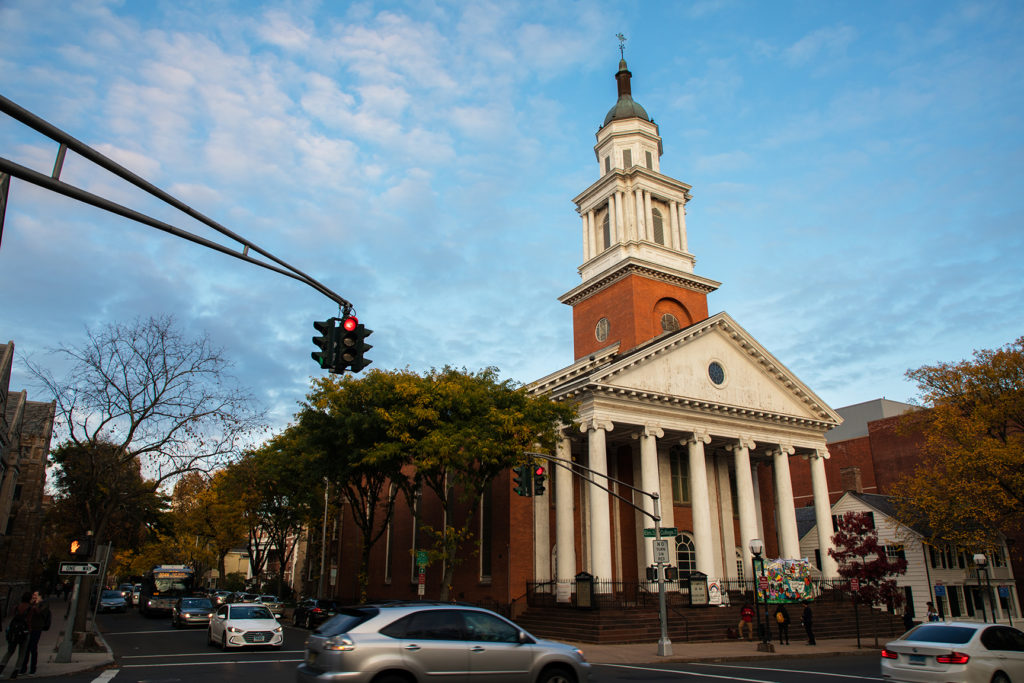
In February, then-pastor Thomas Kim delivered a sermon rebuking President Trump’s executive order banning travel from seven majority-Muslim countries. He encouraged his congregation to put their progressive principles into practice. “I strongly felt that I was called to preach that becoming a sanctuary church is one of the ways that we can be [the] salt and light of the world,” he wrote in an email, referring to a passage from the Gospel of Matthew. “And the members of FSUMC agreed with me.” That spring, the members of the church council voted unanimously to become a sanctuary church, one of the first in Connecticut.
In the past year, the Sanctuary Movement has taken on a new sense of urgency as the Trump Administration cracks down on undocumented immigrants, said Rev. Noel Andersen, the national grassroots coordinator of the Church World Service (CWS), a humanitarian aid organization. Although the tradition of taking sanctuary has ancient origins, the practice became a full-fledged movement in the United States in the 1980s, when churches began providing shelter for those fleeing violence in Central America, whom the U.S. did not recognize as asylum-seekers. CWS has become the “connective tissue” of the Sanctuary Movement, Andersen said, coordinating networks of faith communities across the country. Although sanctuary churches tend to be “progressive-leaning,” he said, they cut across a broad spectrum
of denominations.
For Hahn, agreeing to host Reyes Alvarez was a natural extension of her religious conviction. “When Jesus fed the hungry, I don’t think Jesus asked, ‘Do you have proper I.D.?’” she said. “Jesus just fed people, because he saw the need. For me, it’s the same thing.”
Although many of the churches in the New York Conference of the United Methodist Church—450 congregations scattered across Long Island, New York City, and half of Connecticut—have become sanctuaries in the past year, First and Summerfield is the first to actually host someone. As of November, two other churches in the New Haven area had taken in sanctuary seekers: Iglesia De Dios Pentecostal in Fair Haven, which hosted Chavarria, and the Unitarian Universalist Church in Meriden, which is still hosting sixty-eight-year-old Sujitno Sajuti, who faces deportation to Indonesia.
There are logistical concerns involved in becoming a long-term sanctuary, Fleck says: the building needs to have a kitchen, shower, and makeshift bedroom. But more importantly, a congregation must take the “considerable leap of faith” involved in hosting someone, essentially committing to a massive, protracted advocacy effort and the politicization of its spiritual mission.
“When Jesus fed the hungry, I don’t think Jesus asked, ‘Do you have proper I.D.?’”
After she replied to Fleck’s text, Hahn went back to bed, but couldn’t fall asleep. Eventually, she got up, showered, and began driving toward New Haven in the pale early morning light. She didn’t know anything about Reyes Alvarez, but was heartbroken for him and prepared to give him the protection he needed.
In their homes in Hamden, Wanda Harris and Adeline Tucker, longtime parishioners of First and Summerfield and members of the church’s social concerns committee, had also received early morning messages from Fleck. They arrived at the church at 6 a.m., joining a small group includ- ing Hahn and Fleck waiting for Reyes Alvarez to arrive. All at once, he and his wife entered through the church’s side door on College Street.
“It was intense, it was hurried and rushed,” Fleck said. “We situated him and let him know where everything was.”
Harris and Tucker showed Reyes Alvarez around the labyrinthine building. In the basement was the dining hall with its bright, white-tiled floor and windows just below street level. On the second floor were the offices of the three Yale unions, Locals 33, 34, and 35. On the first floor was the main sanctuary, a large, square room with a gleaming, circular hardwood floor at its center; a soaring, dark-paneled altar-piece; and tall, green stained-glass panels running along two opposing walls.
Just past Hahn’s office, at the end of a dim, blue-walled corridor, was the maroon-carpeted meeting room that would be now be Reyes Alvarez’s bedroom. It was still cluttered with church furniture, which they began to remove and rearrange. There was no bed yet; Fleck would bring one that afternoon. As Reyes Alvarez began to get settled, his immediate family arrived, followed by the thirty relatives who had come to see him off the night before.
“It was really hard to see the family,” Hahn said. “I could tell they cried all night, because their eyes were red. They were shaken, not knowing what would happen.”
By 11 a.m., however, Reyes Alvarez was standing resolute behind the iron fence at the top of the stairs to the church’s main entrance, flanked by his family, Senator Richard Blumenthal, Mayor Toni Harp, church leaders, and ULA organizers, as he addressed a crowd of supporters.
“We came to this country with a lot of dreams and it is very difficult to be going through what we are going through now,” Reyes Alvarez said, as his son-in-law Brian Martinez translated. “Here I am, here is my family, here is my community, and here are all of us who want to live in a better world.”
***
Fanny Torres Reyes enters her husband’s room and sits down at the wooden table next to him. It’s a Monday afternoon and Reyes Alvarez has been living at First and Summerfield for the past seven weeks. Even in the soft light from the chandelier overhead, the strain of their ordeal shows in their faces.
With Reyes Alvarez in sanctuary and unable to work, the family has been struggling to make ends meet. Torres Reyes started housecleaning. Their son Anthony works long days in construction in a nearby town. Their oldest daughter Evelyn, who is studying dental hygiene at Gateway Community College in New Haven, works at a deli, and she and her husband have moved back in with Torres Reyes. When Reyes Alvarez entered First and Summerfield, the family set up an online donation page that, by October, had raised about $3,000 of their $10,000 goal.
The room’s only windows overlook the light brick wall of a Yale School of Music building; there’s rarely any direct sunlight. But Reyes Alvarez and his family have made an effort to make the room feel cozy. There’s a colorful throw folded neatly on a brown couch on one side of the room; cards and flowers line the windowsill. A single bed nestled into a corner of the room almost looks like it was meant to be there. Reyes Alvarez’s heavy-duty toolboxes are stacked one on top of the other, next to his Shop-Vac, at the end of his bed. Along one wall, there’s a bookshelf lined with identical copies of prayer books, a ceramic water jug and a large stack of packaged food.
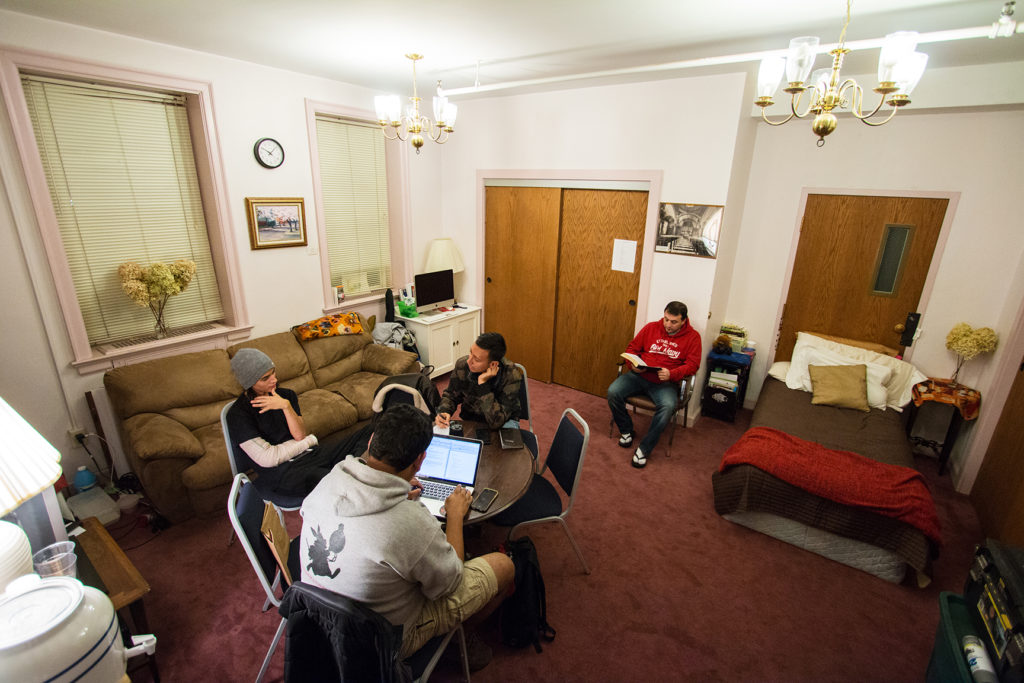
Reyes Alvarez peels open a package of pecan Sandies and offers one to his wife.
“It was a busy day today,” Torres Reyes says with a weary smile, her dark hair pulled back from her face in a high bun.
That morning, she had brought their twelve-year-old daughter Adriana to join a protest of nearly two hundred people at the federal immigration court in Hartford against the imminent deportation of Franklin and Gioconda Ramos. Like Torres Reyes and Reyes Alvarez, the Ramos couple is from Ecuador and live in Meriden. Thirty-six protesters, including Fleck, the pastor of the Hamden Plains UMC, sat in a line in front of the court doors, barring entry; they were charged with disorderly conduct and trespassing.
Usually Adriana comes with her mother to First and Summerfield, but today, tired from the early protest and afterschool soccer, her mother left her home to rest. Hours later, the memory of the morning’s protest, and the Ramos family, seemed to weigh heavily on Torres Reyes.
“We’re from the same country,” she said in a wavering voice, looking down at her hands folded in her lap. “So it’s very hard.”
Reyes Alvarez’s day starts and ends with a small task: switching out the rechargeable battery of his GPS tracker, which ICE officials clamped onto his right ankle in July. It’s a black plastic bracelet that sends data about his location to a private company in Hartford subcontracted by ICE to monitor undocumented immigrants with deportation orders. He has to change the battery every eight hours. If he were to step outside the church, ICE would know immediately.
Reyes Alvarez’s day starts and ends with a small task: switching out the rechargeable battery of his GPS tracker.
“He feels like a slave,” Torres Reyes said. “It’s very uncomfortable. I think he got used to it in some way—resignation that he has to wear it for a while. At the beginning, he was very upset that he had to wear it.”
Reyes Alvarez has about eight visitors every day, he says. ULA organizer Jesus Morales Sanchez is usually with him every weekday, relatives visit on the weekends. His youngest daughter Adriana comes most days after school. Evelyn visits after classes at Gateway, Anthony on the weekends when he’s off work. Some visitors are ULA members who have made it a habit to drop by to see him. Others are complete strangers who have heard about his case and want to offer their support. To each of them, Reyes Alvarez offers a seat on the couch or around the small wooden table at the center of his room.
Within the church building, Reyes Alvarez can use most rooms when he wants to, but he usually goes back and forth between his room and the downstairs dining hall. In the bathroom down the hall from his room, he installed a shower himself, equipped with a stainless-steel handle. His only opportunity for a breath of fresh air is the church’s handicap-accessible entrance, a small garden patio enclosed by a metal fence. He usually just stays inside, although one of their friends always encourages him to go feel the sunlight. “I try,” Reyes Alvarez says wearily.
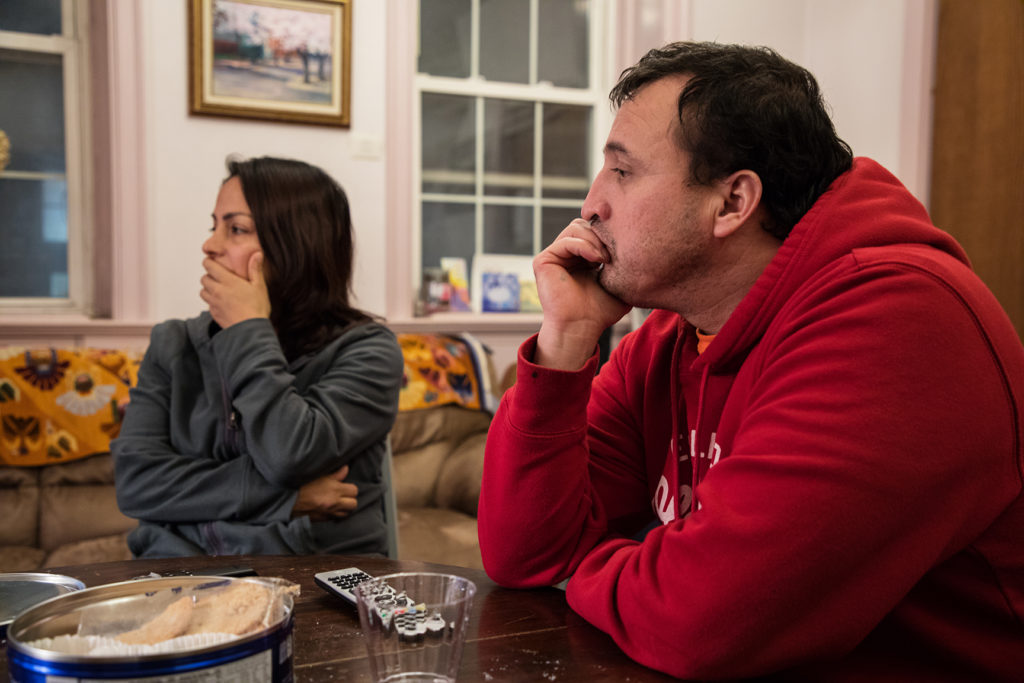
Torres Reyes brings her husband food from home or cooks in the basement kitchen. Sometimes Reyes Alvarez cooks, too. His specialty? White rice.
“It never comes out as good when I make it. He puts something special in it,” Torres Reyes says, laughing.
“It’s a secret!” Reyes Alvarez responds with a chuckle.
If no one is visiting, he cooks in the kitchen downstairs, does push-ups, or listens to Bob Marley. In his room, there’s an old television set and a stack of dramas on VCR, although if Reyes Alvarez ever watches something, it’s usually Christian movies on Netflix on a desktop in the corner of the room.
Back in Ecuador, he played on a travel soccer team and follows his favorite team, Barcelona, with intensity. But he’s missing out on the games that matter the most: Adriana’s. “It’s hard because I like soccer, I want to see my daughter… oh my God,” he says, his voice breaking.
“I’m most scared because I don’t have any answer for my kids if I have to go back to my country. I don’t want to separate my family.”
Reyes Alvarez met Torres Reyes when he was sixteen years old; they both grew up in Mera, a small town in central Ecuador, in the foothills of the Andes. In 1997, when their oldest children were toddlers, Reyes Alvarez paid smugglers known as coyotajes seven thousand dollars to make the two- week journey to the United States border. He and forty others were driven from Ecuador to Mexico, then walked to Texas. A bus and a train later, he was arrived in New Haven, where Torres Reyes’ brother had already settled. In 2000, after he became established in the area, his wife joined him. A year later, they had enough money to rent a bigger apartment in Wallingford, and their children came too. Five years later, they moved to Meriden, and other relatives soon followed suit, settling in the area.
In 2007, on a family trip to Michigan, the family’s GPS took them off course and they accidentally drove across the border into Canada. Reyes Alvarez was detained for a week- end until his family posted bail. The incident identified him to the U.S. Department of Homeland Security, which lead to him being placed in removal proceedings, his attorney O’Neil-Baker said. Two years later, he received a removal order. Over the following years, repeated attempts to reopen his case were denied.
Torres Reyes tries to come to First and Summerfield every day and often stays the night so that her husband won’t be alone. When she’s not there, he sometimes can’t sleep or won’t eat, she says. Although he has adopted a daily rhythm, there is no getting used to life in purgatory.
“I’m most scared because I don’t have any answer for my kids if I have to go back to my country,” he said. “I don’t want to separate my family.”
***
The door through which Reyes Alvarez fled deportation now marks the limit of his world. The entrance to 425 College Street, the side door of First and Summerfield, is made of dull metal, with a scratched, square window at eye level. Between eight in the morning and five in the evening, it’s unlocked, constantly opening and closing with the flow of people through the building. After hours, visitors must press a buzzer to be let in. For the past three months, this door has been the only thing between Reyes Alvarez’s current safety and the certain deportation that lurks beyond. On the inside, he’s protected through ICE’s “sensitive locations” policy; on the outside, he’s vulnerable to immediate arrest.
Though ICE has kept its word on sensitive locations, immigration activists worry that the policy isn’t permanent. “[ICE] says it won’t do anything in those buildings, but that can change from one day to another,” said John Jairo Lugo. “Maybe one day we’ll wake up with a new memo from the government, and that would be a nightmare for undocumented immigrants.”
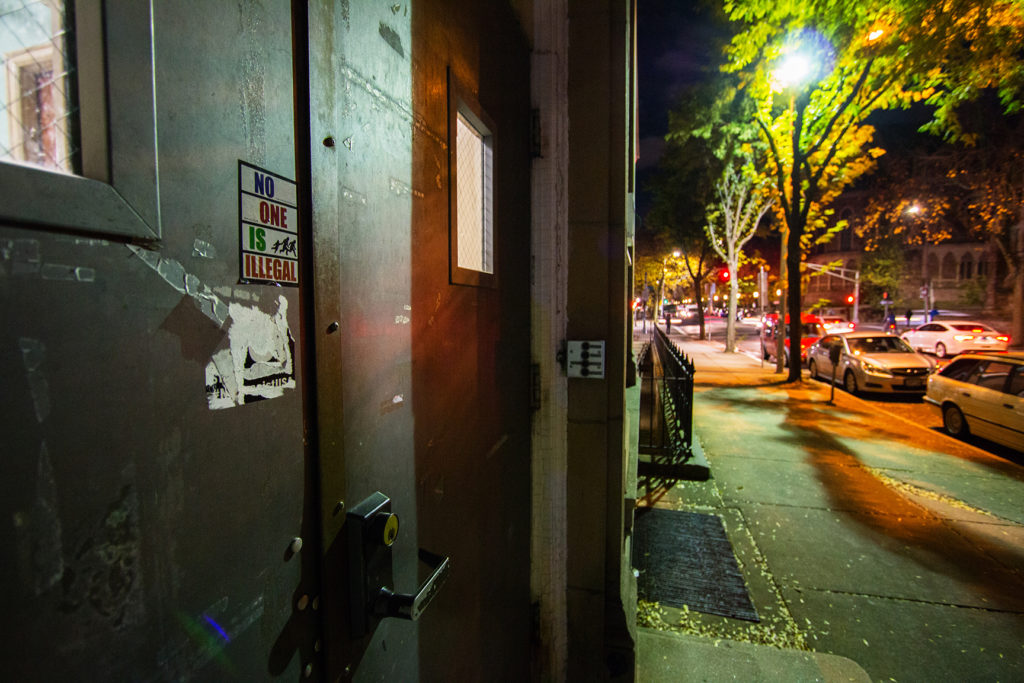
This past spring, Paul Fleck said, a group of religious leaders from the New Haven area met with Deirdre Daly, the U.S. Attorney for the District of Connecticut, and an ICE community relations officer, who affirmed that agents would not enter sanctuary spaces unless in the case of a public threat. Even so, he said, “my trust for ICE is rather limited.”
“It’s just striking the American public now what an arbitrary, worse than Kafka-esque, rogue agency, in many senses [ICE] is,” said Ramon Garibaldo Valdez, a member of ULA and second-year student in Yale’s political science PhD program. “We’re just going off this intuition [that] they have usually been somewhat respectful of churches, but that precedent does not stand on very strong ground.”
New Haven is a sanctuary city, which means that its police officers cannot provide assistance to ICE in the case of a federal immigration action or inquire about someone’s immigration status. But the sanctuary city status is less secure than many realize; it’s a federal designation that has no substantial legal backing.
“We’re blind to status,” Mayor Toni Harp told me one morning at City Hall. Since the early 2000s, the New Haven Police Department has had a general order stating that officers do not ask people for their immigration status. Public school officials are not supposed to inquire about a student’s status either, and city services are based on residency, not place of origin, she said.
Yet there has been no real push from the New Haven Board of Alders to formally undergird the city’s sanctuary status, Harp added. The Trump administration’s threat to pull federal funding from sanctuary cities doesn’t weaken the city’s commitment to protecting undocumented immigrants, she said, but city leaders don’t want to put a bullseye on New Haven. So, they have adopted more modest measures, like distributing five-thousand copies of a pocket-sized “Family Emergency Preparedness Guide” to schools, hospitals, and libraries, to inform undocumented immigrants of their rights in case ICE agents show up at their door.
A decade ago, New Haven experienced federal backlash after instituting measures to support its undocumented residents. On June 5, 2007, the city launched its Elm City Resident card, a first-of-its-kind municipal identification card for undocumented immigrants. Less than two days later, ICE agents conducted a massive raid in Fair Haven, arresting 32 residents. In the carefully-selected words of City Hall spokesman Laurence Grotheer, the federal government “took exception” to the city’s new ID program. In the words of Jairo Lugo, the raid was a flat-out “retaliation.”
“Just today, I heard they’re going to start doing raids in California because the government there wants to keep the state a sanctuary,” he said on the phone one afternoon in October. He fears that something similar may soon happen in New Haven. “We don’t know when, but we’re getting ready for it.”
Even in his secluded room in First and Summerfield, the ever-present threat of an ICE raid hangs over Reyes Alvarez and his family. After all, the side door is almost always unlocked.
“We pray a lot to be safe,” said Torres Reyes. “That’s why most of the time, someone is here with me, either me or Jesus [Morales Sanchez] or John Jairo [Lugo]…because if something happens, they can be witnesses of what’s going on.”
***
Over the past three months, the front steps of First and Summerfield have become a gathering place for political action in New Haven. Reyes Alvarez’s supporters flocked to the nine brown stone steps when he first entered the church, and later, when the Trump Administration announced its decision to rescind DACA. It is here that city and state officials have pledged their support for Reyes Alvarez and his family.
But it hasn’t always been the case that high-profile legislators, or even the mayor, have showed up to support cases like these. “Back in the day, we had to beg them to support us, but they’ve become more willing to work with the immi- grant community,” Jairo Lugo said. “At the same time, it’s good for the case when they are in solidarity with Marco.”
On the day of Reyes Alvarez’s arrival at First and Summerfield, Senator Blumenthal stood behind the iron fence where a neon green sign read “IMMIGRANTS MAKE AMERICA” and called for a new hearing in Reyes Alvarez’s case. “Our country is better than the policies that have been adopted in the last seven months and focus on people who have lived here for decades, worked hard, paid taxes, raised families,” Blumenthal said over the noise of buses rumbling down Elm Street. “Our country is better than policies that tear apart families.”
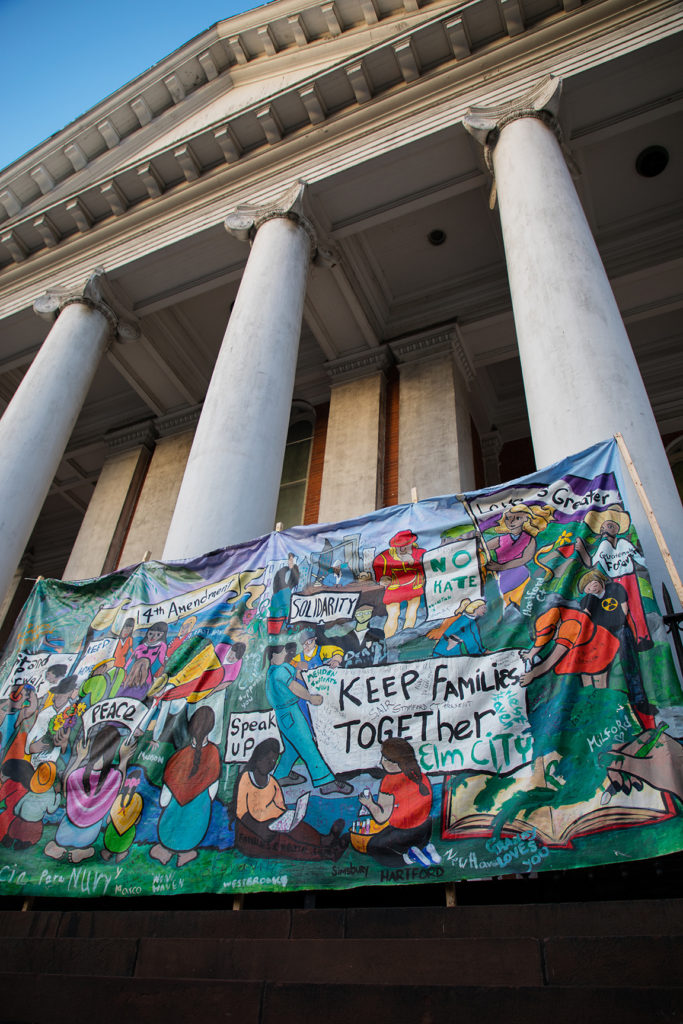
Connecticut politicians like Blumenthal and U.S. Representative Rosa DeLauro say that the ICE policies that have singled out undocumented immigrants like Ryes Alvarez betray the unusual malice of the Trump administration.
“One policy the president spoke about was that the deportations would target dangerous felons, not upstanding members of our community like Mr. Reyes,” said DeLauro, who has also attended rallies for Reyes Alvarez, told me in October. “The administration has lied about what they said they were doing. It’s a cruel reversal of policy.”
DeLauro sees Reyes Alvarez’s case in the context of the long haul: comprehensive immigration reform. “If we win back the House of Representatives, we can change a number of these policies that have been willy-nilly reversed,” she said.
“The administration has lied about what they said they were doing. It’s a cruel reversal of policy.”
The 2018 election, however, is a long time for Reyes Alvarez to wait. For him, life continues, day-by-day, in his small room in a corner of First and Summerfield, far from the noise of the church’s front steps. By nature a quiet man, over the past few months, Reyes Alvarez has become a spokes- man for the predicament that he, and many other undocumented immigrants, now find themselves in. It’s a role he doesn’t seem entirely comfortable with, but has come to accept.
“All of us are afraid—but not all of us can do what I am doing either,” he says in Spanish one afternoon in October. “Everyone always waits for another to sacrifice themselves, so I guess, recently, it’s my turn. But it’s not that anyone would want to be here and call attention to themselves to say something. I just did it to stay with my family and my wife.”
Ramon Garibaldo Valdez says that people tend to under- estimate the force of Reyes Alvarez’s will. He’s isn’t a victim, Garibaldo Valdez says, but has fully accepted responsibility for his decision to take sanctuary. He speaks at rallies that aren’t even about his case, supporting ULA members in any way he can. “I don’t think the first thing that comes to his mind is ‘I’ve been in this country for twenty years.’ I think it’s the idea that ‘I have to be here for another twenty years for my children, especially my youngest, Adriana.’”
“If people want to get a sense of urgency for immigration, they shouldn’t look at large picture data on immigration, they should just see this one case,” Garibaldo Valdez added. “The possibility of Adriana staying without a father…that’s what people need to center.”
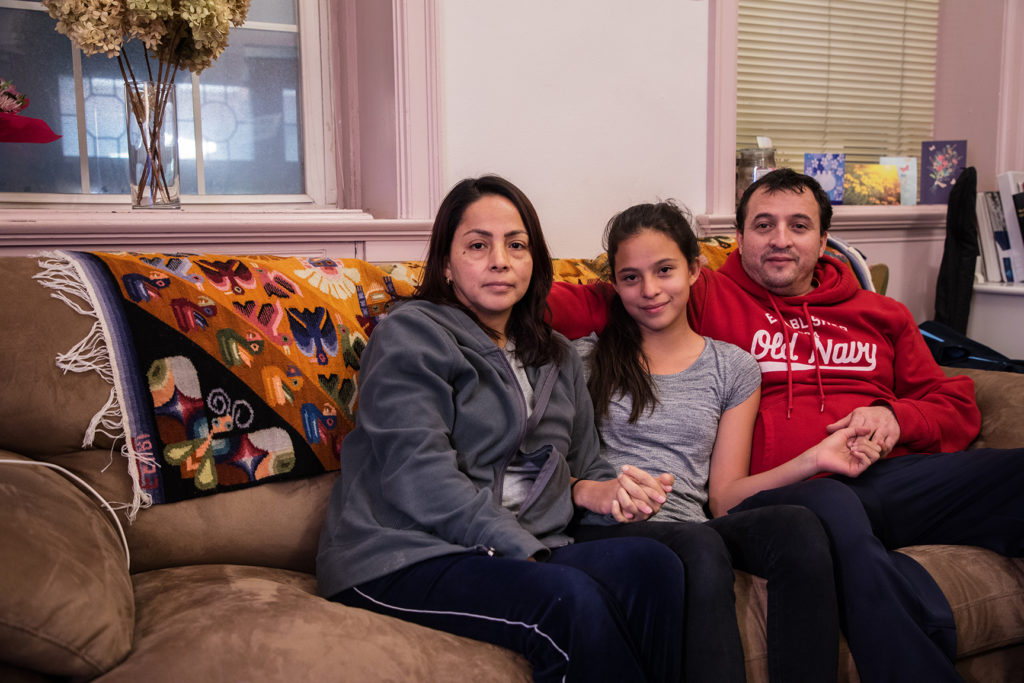
Although Torres Reyes and the children can return home at night, the anxiety and gravity of Reyes Alvarez’s predicament has upended their lives, too. The result of the motion to reopen his case could come tomorrow, or next month, or next year. For all of them, as the weeks pass, First and Summerfield feels less like a refuge and more like a prison.
***
On a Monday night in October, the sanctuary of First and Summerfield is full of voices, as dozens of people take seats in a circle of chairs. John Jairo Lugo, wearing an imitation bird foot around his neck, balances a laptop on his knees and calls the weekly ULA meeting to order.
It’s Columbus Day—Indigenous Peoples’ Day—and Jairo Lugo is wearing a black shirt with an image of Native Americans and “Homeland Security Fighting Terrorism Since 1492” written in white block print. Fluorescent light from the streetlamps filters through the church’s stained-glass windows. The doors next to the altar are open, and across the hall, a square of light glows in the window of the door to Reyes Alvarez’s room. His wife emerges with a few other relatives and takes a seat.
Jairo Lugo asks if there are any cases people want to discuss. There’s a family across the circle from Torres Reyes, a father and mother with a small boy leaning against their legs. The man stands, his hair slicked back, hands shoved into his pockets. He has a deportation order for early November, he says. A few seats down from Torres Reyes, a woman who has been fighting a deportation order says that she must present herself for supervision in the next few weeks.
In the New Haven area, there are two or three new cases like Reyes Alvarez’s every week, Jairo Lugo later tells me over the phone from outside the federal immigration court- house in Hartford: “We walked out from the courthouse and just picked a new case.” The frequency of these cases has rapidly increased since the election, and in his mind, it’s only going to worsen.
“There’s a huge increase of people who are doing what they need to do—showing up to check in—who are then notified that they have to leave the country, their stays are denied, and they are placed on a GPS unit,” Reyes Alvarez’s attorney O’Neil-Baker said.
Since ICE agents sometimes show up at court when undocumented immigrants attempt to appear for their court dates, ULA organizes groups that can accompany them, a show of emotional but also physical support.
“We believe that ICE is much more likely to not detain someone if they see people around them, and even if they were to do that, it helps us because we know it happened, we have witnesses, people recording badge numbers,” says Morales Sanchez.
“We’re going to do anything that is in our power. We’re going to interrupt your operations. We’re going to make noise outside your offices.”
Reyes Alvarez’s case now hinges upon a decision from the Board of Immigration Appeals that could come any day, or not for a long time. There is little organizing that could swing the balance in his favor. But for other cases, like that of Franklin and Gioconda Ramos, acts of civil disobedience can make a difference, Morales Sanchez says.
“We’re going to do anything that is in our power. We’re going to interrupt your operations. We’re going to make noise outside your offices, or in the case a few weeks ago, we’re going to sit down and not let anyone into your building,” he adds, referring to ICE. “We’re going to disrupt your day and hopefully, that disruption will add enough pressure to have them change their minds.”
At the end of the ULA meeting, Torres Reyes chats with some of the other members and helps dismantle the circle, stacking chair after chair in the corner. Then she slips away across the hall, into the room where her husband’s light is still on.
***
At 10 a.m. on a Sunday morning in October, the bell tower of First and Summerfield begins to chime and Reyes Alvarez and his wife walk into the light-filled sanctuary.
“Hi, Fanny, how are you doing?” says one of the elderly greeters at the threshold.
“I’m O.K.,” she responds with a quiet smile.
“It’s hard, it’s hard,” the woman says, embracing her.
Reyes Alvarez goes over to a small display at the entrance to the church and picks out his plastic nametag, like the other parishioners. As others trickle in, he and his wife take their seats facing the altar, near the front.
Despite the overcast sky and drizzle outside, the tall green and yellow stained-glass windows on either side of the room shimmer with light. About twenty people have come to the service this morning, and though there are many empty seats, the room echoes with the voices of children.
Pastor Juhye Hahn, dressed in white and green vestments, stands behind a lectern, her voice ringing out high and clear as she calls the congregation to worship. The lectern’s dark wood perfectly matches the soaring altarpiece behind her. Its elegant, rectangular base supports a thin wooden cross and is topped with an angled square that holds her Bible. It is positioned a few feet in front of the altar; Hahn is close enough to hold the gaze of individual parishioners. Reyes Alvarez built the lectern over a few days in the church’s sub-basement. It is his gift to the congregation.
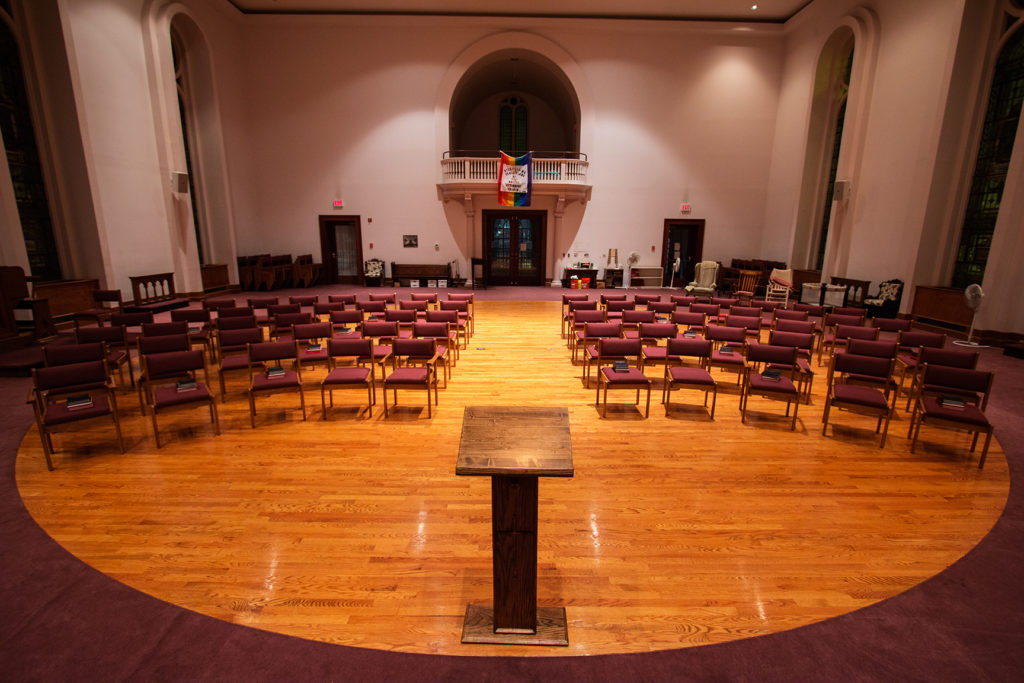
When Hahn became First and Summerfield’s pastor this July, she didn’t want to stand behind the altar because she felt disconnected from her parishioners. For a few weeks, she used a black metal music stand, since the church didn’t have the funds to buy a portable lectern. Reyes Alvarez has already spent many hours working on projects around the church—fixing shelves in the kitchen, repainting the wainscoting in the dining hall—and when he heard that Hahn was looking for a new lectern, he offered to help.
“At the beginning, we thought we were doing something for him. But actually, he is the blessing for us.”
The hardest part of building the lectern was getting the materials, Torres Reyes said. She had to track down all her husband’s tools in their home and her brother’s backyard shed. Then there was the two-hour trip to Home Depot, video-calling him in the middle of the aisle to show him all the possible wood grains and stains.
“He was the one who always [went] to that place, so I would show him, ‘This one or this one?’” Torres Reyes said, laughing. “And he would say, ‘Yes, this one,’ ‘No, no, no, bring that one!’”
Eventually they settled on oak, because Reyes Alvarez wanted to build something that would last. Torres Reyes had the wood cut and brought it back to the church. Reyes Alvarez set up carpentry horses in the basement, brought down his tools and an air compressor, and got to work. It took only two days, he said, but he had to wait another week for the wood stain to dry because the basement was so humid. On a Sunday in October, they presented the lectern to the congregation.
“It’s not just a lectern,” Hahn said. “I mean, I’m happy to have that lectern, but for me personally, it’s a witness. God answered the prayer that I had in a mysterious way.” She pauses to reflect. “At the beginning, we thought we were doing something for him. But actually, he is the blessing for us.”
For the foreseeable future, Reyes Alvarez will continue living in First and Summerfield, waiting to hear if his motion for asylum is granted and greeting the visitors who stop by every now and then. When the side door opens, snatches of sound from the city street drift down the hall to his room. From time to time, he’ll step onto the patio for a little air, though it’s getting cold now. On Sundays, he’ll attend the church service and the coffee hour afterwards. And when he can, he will retreat to the basement to work on his next project, a wooden baptismal font in which to display the church’s bare silver bowl. It will be modest but solid, he says. A simple thing of beauty, built with the hope that it will remain in the sanctuary far longer than its creator.
Eddie Joe Antonio Pérez provided Spanish translations.
Correction, Jan. 3: A previous version of this article misstated the year that the Elm City Resident card was launched. It was 2007, not 2006.


